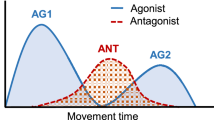Summary
Fast goal-directed voluntary movements of the human upper extremity are known to be associated with three distinct bursts of EMG activity in antagonistic muscles. The role of each burst (AG1, ANT, AG2) in controlling motion is not fully understood, largely because overall limb response is a complex function of the entire sequence of bursts recorded during experimental trials. In order to investigate the role of each burst of muscle activity in controlling motion, we studied fast voluntary arm movements and also developed two simulation techniques, one employing a mathematical model of the limb and the other using electrical stimulation of human arm muscles. These techniques show that two important movement parameters (peak displacement, time to reach peak displacement) are non-linear functions of the magnitude of the antagonist input (torque and stimulation voltage, respectively, in our two simulations). In the fastest movements, the agonist muscle is primarily responsible for the distance moved, while the antagonist muscle provides an effective means of reducing movement time. The third component of the triphasic pattern moderates the antagonist braking forces and redirects the movement back to the target.
Similar content being viewed by others
References
Angel RW (1975) Myoelectric patterns associated with ballistic movements: effect of unexpected changes in load. J Hum Mvmt Stud 1: 96–103a
Brown SHC, Cooke JD (1981) Amplitude and instruction-dependent modulation of movement-related electromyogram activity in humans. J Physiol (Lond) 316: 97–107
Brown SHC, Cooke JD (1984) Initial agonist burst duration depends on movement amplitude. Exp Brain Res 55: 523–527
Flament D, Hore J, Vilis T (1984) Braking of fast and accurate elbow flexions in the monkey. J Physiol (Lond) 349: 195–203
Ghez C (1979) Contributions of central programs to rapid limb movement in the cat. In: Asanuma H, Wilson VJ (ed) Integration in the nervous system. Isaku-Shoin Ltd, Tokyo, pp 305–319
Ghez C, Martin JH (1982) Control of rapid limb movement in the cat. Exp Brain Res 45: 115–125
Hallett M, Marsden CD (1979) Ballistic flexion movements of the human thumb. J Physiol (Lond) 294: 33–50
Hallett M, Shahani BT, Young RR (1975) Analysis of stereotyped voluntary movements in man. J Neurol Neurosurg Psychiat 38: 1154–1162
Hannaford B, Stark L (1985) Roles of the elements of the triphasic control signal. Exp Neurol 90: 619–634
Hayes KC, Hatze H (1977) Passive visco-elastic properties of the structures spanning the human elbow joint. Eur J Appl Physiol 37: 265–274
Hoffman DS, Strick PL (1984) Controlled variables in steptracking movements of the wrist. Neurosci Abstr 10: 332
Katz B (1939) The relation between force and speed in muscular contraction. J Physiol (Lond) 96: 46–64
Lehman SL, Houk JC (1984) Adaptations of human wrist movements to inertial loads. Neurosci Abstr 10: 332
Lestienne F (1979) Effects of inertial load and velocity on the braking process of voluntary limb movements. Exp Brain Res 35: 407–418
Marsden CD, Obeso JA, Rothwell JC (1983) The function of the antagonist muscle during fast limb movements in man. J Physiol 335: 1–13
Meinck HM, Benecke R, Meyer W, Hohne J, Conrad B (1984) Human ballistic finger flexion: uncoupling of the three-burst pattern. Exp Brain Res 55: 127–133
Shahani BT, Young RR (1979) Processing of centrally programmed motor commands. Neurosci Abstr 5: 386
Shahani BT (1983) Control of voluntary activity in man and physiological principles of biofeedback. In: Shahani BT (ed) Electromyography in CNS disorders: central EMG. Butterworth, Boston London, pp 161–175
Terzuolo CA, Soechting JF, Viviani P (1973) Studies on the control of some simple motor tasks. I. Relations between parameters of movements and EMG activities. Brain Res 58: 212–216
Wachholder K, Altenburger H (1926) Beiträge zur Physiologie der willkürlichen Bewegung. X. Einzelbewegungen. Pflügers Arch Ges Physiol 214: 642–661
Wadman WJ, Denier van der Gon JJ, Geuze RH, Mol CR (1979) Control of fast goal-directed arm movements. J Hum Mvmt Stud 5: 3–17
Waters P, Strick PL (1981) Influence of ‘strategy’ on muscle activity during ballistic movements. Brain Res 207: 189–194
Wiegner AW, Watts RL (1986) Elastic properties of muscles measured at the elbow in man. I. Normal controls. J Neurol Neurosurg Psychiatry (in press)
Author information
Authors and Affiliations
Rights and permissions
About this article
Cite this article
Wierzbicka, M.M., Wiegner, A.W. & Shahani, B.T. Role of agonist and antagonist muscles in fast arm movements in man. Exp Brain Res 63, 331–340 (1986). https://doi.org/10.1007/BF00236850
Received:
Accepted:
Issue Date:
DOI: https://doi.org/10.1007/BF00236850




